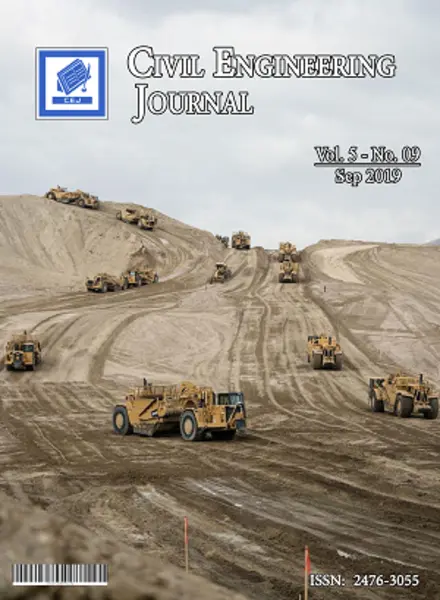-
double-curvature test of reinforced concrete columns using shaking table: a new test setup
جزئیات بیشتر مقاله- تاریخ ارائه: 1400/08/01
- تاریخ انتشار در تی پی بین: 1400/08/01
- تعداد بازدید: 591
- تعداد پرسش و پاسخ ها: 0
- شماره تماس ژورنال: 982188779475ext.258
double-curvature test of reinforced concrete columns using shaking table: a new test setup
this paper proposes a new test setup to study the double-curvature behavior of reinforced concrete (rc) columns using shaking table. in this setup, the seismic action is simulated by the horizontal movement of a long-heavy rigid mass sitting on the top of only one test specimen. the double-curvature mechanism of specimen is affected by the movement of the concrete mass on a test rig consisting four steel hollow-section columns fully anchored to the shaking table. application of axial load on the specimen is made possible through a pre-stressing equipment connecting to its top and bottom bases. the current setup offers two improvements over the previous ones. first, it makes available greater ranges of test data for conducting bigger sizes of the specimens. second, it allows to directly measure the variation of axial force in the test specimens while the test implementation can be fast and easy with a high safety margin even until the complete collapse of the test units. the current test setup has been successfully applied on two ½ scaled v-shaped columns. it has been shown that the column specimen with a low axial load level of 0.05f’cag, where f’c is the concrete strength and ag is the cross-sectional area of the specimen, can well survive at a ground peak acceleration up to 5.5 (m/s2) with a drift ratio of approximately 2.91%. meanwhile, the column subjected to moderate axial load level of 0.15f’cag can survive at a higher ground peak acceleration of 8.0 (m/s2) with a drift ratio of 3.75%. furthermore, it is experimentally evidenced that the v-shaped cross-section does not deform in-plane under seismic action. the angle between two planes corresponding to the column web and flange are up to 0.03 (rad). this finding is significant since it contradicts the plane strain assumption available in the current design practice.
حوزه های تحت پوشش ژورنال
مقالات جدیدترین رویدادها
-
استفاده از تحلیل اهمیت-عملکرد در ارائه الگوی مدیریت خلاقیت سازمانی و ارائه راهکار جهت بهبود
-
بررسی تاثیر ارزش وجوه نقد مازاد بر ساختار سرمایه شرکت های پذیرفته شده در بورس اوراق بهادار تهران
-
بررسی تأثیر سطح افشای ریسک بر قرارداد بدهی شرکت های پذیرفته شده در بورس اوراق بهادار تهران
-
بررسی تأثیر رتبه بندی اعتباری مبتنی بر مدل امتیاز بازار نوظهور بر نقد شوندگی سهام با تأکید بر خصوصی سازی شرکت ها
-
تأثیر آمیخته بازاریابی پوشاک ایرانی بر تصویر ذهنی مشتری پوشاک ایرانی (هاکوپیان)
-
مقایسه ی استانداردهای اورژانس مصوب وزارت بهداشت، درمان و آموزش پزشکی با اصول نظام ایزو 9001 ویرایش 2000
-
بررسی نیازهای آموزشی بیماران ترخیصی و رضایتمندی آنها از عملکرد آموزشی پرستاران در کرمان
-
نقش تعلق گروهی بر انگیزه پیشرفت تحصیلی دانش آموزان
-
بررسی آسیب های کروموزومی در لنفوسیت های کارکنان اتاق عمل ناشی از استنشاق گازهای بیهوشی به روش آنالیز متافاز
-
application of a force-based state space approach to geometrically nonlinear planar curved beams
مقالات جدیدترین ژورنال ها
-
مدیریت و بررسی افسردگی دانش آموزان دختر مقطع متوسطه دوم در دروان کرونا در شهرستان دزفول
-
مدیریت و بررسی خرد سیاسی در اندیشه ی فردوسی در ادب ایران
-
واکاوی و مدیریت توصیفی قلمدان(جاکلیدی)ضریح در موزه آستان قدس رضوی
-
بررسی تاثیر خلاقیت، دانش و انگیزه کارکنان بر پیشنهادات نوآورانه کارکنان ( مورد مطالعه: هتل های 3 و 4 ستاره استان کرمان)
-
بررسی تاثیر کیفیت سیستم های اطلاعاتی بر تصمیم گیری موفق در شرکتهای تولیدی استان اصفهان (مورد مطالعه: مدیران شرکتهای تولیدی استان اصفهان)
-
عدم شفافیت و اجتناب مالیاتی
-
به کارگیری مهاربندهای کمانش گریز در بهسازی قاب های خمشی فولادی
-
بررسی تأثیر نام تجاری و وفاداری برند در خدمات فن آوری
-
phatics - actual problems of linguistics uzbek research
-
performance of concrete mrf at near-field earthquakes compared to far-field earthquakes


سوال خود را در مورد این مقاله مطرح نمایید :